No Silver Bullet
—Essence and Accident in Software Engineering
Frederick P. Brooks, Jr.
University of North Carolina at Chapel Hill
There is no single development, in either technology or management
technique, which by itself promises even one order-of-magnitude
improvement within a decade in productivity, in reliability, in simplicity.
Abstract1
All software construction involves essential tasks, the fashioning of the complex
conceptual structures that compose the abstract software entity, and accidental tasks, the
representation of these abstract entities in programming languages and the mapping of
these onto machine languages within space and speed constraints. Most of the big past
gains in software productivity have come from removing artificial barriers that have
made the accidental tasks inordinately hard, such as severe hardware constraints,
awkward programming languages, lack of machine time. How much of what software
engineers now do is still devoted to the accidental, as opposed to the essential? Unless it
is more than 9/10 of all effort, shrinking all the accidental activities to zero time will not
give an order of magnitude improvement.
Therefore it appears that the time has come to address the essential parts of the
software task, those concerned with fashioning abstract conceptual structures of great
complexity. I suggest:
•
•
Exploiting the mass market to avoid constructing what can be bought.
Using rapid prototyping as part of a planned iteration in establishing software
requirements.
Growing software organically, adding more and more function to systems as they are
run, used, and tested.
Identifying and developing the great conceptual designers of the rising generation.
•
Introduction
•
Of all the monsters who fill the nightmares of our folklore, none terrify more than
werewolves, because they transform unexpectedly from the familiar into horrors. For
these, we seek bullets of silver than can magically lay them to rest.
1 Reproduced from: Frederick P. Brooks, The Mythical Man-Month, Anniversary edition with 4 new
chapters, Addison-Wesley (1995), itself reprinted from the Proceedings of the IFIP Tenth World
Computing Conference, H.-J. Kugler, ed., Elsevier Science B.V., Amsterdam, NL (1986) pp. 1069-76.
�
F. Brooks: No Silver Bullet—Essence and accident in software engineering (1986)
2
The familiar software project has something of this character (at least as seen by the
non-technical manager), usually innocent and straightforward, but capable of becoming a
monster of missed schedules, blown budgets, and flawed products. So we hear desperate
cries for a silver bullet, something to make software costs drop as rapidly as computer
hardware costs do.
But, as we look to the horizon of a decade hence, we see no silver bullet. There is no
single development, in either technology or management technique, which by itself
promises even one order of magnitude improvement in productivity, in reliability, in
simplicity. In this chapter we shall try to see why, but examining both the nature of the
software problem and the properties of the bullets proposed.
Skepticism is not pessimism, however. Although we see no startling breakthroughs,
and indeed, believe such to be inconsistent with the nature of software, many
encouraging innovations are under way. A disciplined, consistent effort to develop,
propagate, and exploit them should indeed yield an order-of-magnitude improvement.
There is no royal road, but there is a road.
The first step toward the management of disease was replacement of demon theories
and humours theories by the germ theory. That very step, the beginning of hope, in itself
dashed all hopes of magical solutions. It told workers the progress would be made
stepwise, at great effort, and that a persistent, unremitting care would have to be paid to a
discipline of cleanliness. So it is with software engineering today.
Does It Have To Be Hard? – Essential Difficulties
Not only are there no silver bullets now in view, the very nature of software makes it
unlikely that there will be any−no inventions that will do for software productivity,
reliability, and simplicity what electronics, transistors, and large-scale integration did for
computer hardware. We cannot expect ever to see twofold gains every two years.
First, we must observe that the anomaly is not that software progress is so slow but
that computer hardware progress is so fast. No other technology since civilization began
has seen six orders of magnitude price-performance gain in 30 years. In no other
technology can one choose to take the gain in either improved performance or in reduced
costs. These gains flow from the transformation of computer manufacture from an
assembly industry into a process industry.
Second, to see what rate of progress we can expect in software technology, let us
examine its difficulties. Following Aristotle, I divide them into essence−the difficulties
inherent in the nature of the software−and accidents−those difficulties that today attend
its production but that are not inherent.
The accidents I discuss in the next section. First let us consider the essence.
The essence of a software entity is a construct of interlocking concepts: data sets,
relationships among data items, algorithms, and invocations of functions. This essence is
abstract,
the same under many different
representations. It is nonetheless highly precise and richly detailed.
the conceptual construct
I believe the hard part of building software to be the specification, design, and testing
of this conceptual construct, not the labor of representing it and testing the fidelity of the
representation. We still make syntax errors, to be sure; but they are fuzz compared to the
conceptual errors in most systems.
is
in
that
�
F. Brooks: No Silver Bullet—Essence and accident in software engineering (1986)
3
If this is true, building software will always be hard. There is inherently no silver
bullet.
Let us consider the inherent properties of this irreducible essence of modern software
systems: complexity, conformity, changeability, and invisibility.
Complexity. Software entities are more complex for their size than perhaps any other
human construct, because no two parts are alike (at least above the statement level). If
they are, we make the two similar parts into one, a subroutine, open or closed. In this
respect software systems differ profoundly from computers, buildings, or automobiles,
where repeated elements abound.
Digital computers are themselves more complex than most things people build; they
have very large numbers of states. This makes conceiving, describing, and testing them
hard. Software systems have orders of magnitude more states than computers do.
Likewise, a scaling-up of a software entity is not merely a repetition of the same
elements in larger size; it is necessarily an increase in the number of different elements.
In most cases, the elements interact with each other in some nonlinear fashion, and the
complexity of the whole increases much more than linearly.
The complexity of software is in essential property, not an accidental one. Hence
descriptions of a software entity that abstract away its complexity often abstract away its
essence. Mathematics and the physical sciences made great strides for three centuries by
constructing simplified models of complex phenomena, deriving properties from the
models, and verifying those properties experimentally. This worked because the
complexities ignored in the models were not the essential properties of the phenomena. It
does not work when the complexities are the essence.
Many of the classical problems of developing software products derived from this
essential complexity and its nonlinear increased with size. From the complexity comes
the difficulty of communication among team members, which leads to product flaws, cost
overruns, schedule delays. From the complexity comes the difficulty of enumerating,
much less understanding, all the possible states of the program, and from that comes the
unreliability. From the complexity of the functions comes the difficulty of invoking those
functions, which makes programs hard to use. From complexity of structure comes the
difficulty of extending programs to new functions without creating side effects. From the
complexity of structure comes the unvisualized state that that constitute security
trapdoors.
Not only technical problems but management problems as well come from the
complexity. This complexity makes overview hard, thus impeding conceptual integrity.
It makes it hard to find and control all the loose ends. It creates the tremendous learning
and understanding burden that makes personnel turnover a disaster.
Conformity. Software people are not alone in facing complexity. Physics deals with
terribly complex objects even at the “fundamental” particle level. The physicist labors
on, however, in a firm faith that there are unifying principles to be found, whether in
quarks or in unified field theories. Einstein repeatedly argued that there must be
simplified explanations of nature, because God is not capricious or arbitrary.
No such faith comforts the software engineer. Much of the complexity he must
master is arbitrary complexity, forced without rhyme or reason by the many human
�
F. Brooks: No Silver Bullet—Essence and accident in software engineering (1986)
4
institutions and systems to which his interfaces must confirm. These differ from interface
to interface, and from time to time, not because of necessity but only because they were
designed by different people, rather than by God.
In many cases the software must confirm because it has most recently come to the
scene. In others it must conform because it is perceived as the most conformable. But in
all cases, much complexity comes from conformation to other interfaces; this cannot be
simplified out by any redesign of the software alone.
Changeability. The software entity is constantly subject to pressures for change. Of
course, so are buildings, cars, and computers. But manufactured things are infrequently
changed after manufacture; they are superseded by later models, or essential changes are
incorporated in later serial-number copies of the same basic design. Callbacks of
automobiles are really quite infrequent; field changes of computers somewhat less so.
Both are much less frequent than modifications to fielded software.
Partly this is because the software in a system embodies its function, and the function
is the part that most feels the pressures of change. Partly it is because software can be
changed more easily−it is pure thought-stuff, infinitely malleable. Buildings do in fact
get changed, but the high costs of change, understood by all, serve to dampen the whim
of the changers.
All successful software gets changed. Two processes are at work. As a software
product is found to be useful, people try it in new cases at the edge of, or beyond, the
original domain. The pressures for extended function come chiefly from users who like
the basic function and invent new uses for it.
Second, successful software also survives beyond the normal life of the machine
vehicle for which it is first written. If not new computers, then at least new disks, new
displays, new printers come along; and the software must be conformed to its new
vehicles of opportunity.
In short, the software product is embedded in a cultural matrix of applications, users,
laws, and machine vehicles. These all change continually, and their changes inexorably
force change upon the software product.
Invisibility. Software is invisible and unvisualizable. Geometric abstractions are
powerful tools. The floor plan of a building helps both architect and client evaluate
spaces, traffic flows, and views. Contradictions become obvious, omissions can be
caught. Scale drawings of mechanical parts and stick-figure models of molecules,
although abstractions, serve the same purpose. A geometric reality is captured in a
geometric abstraction.
The reality of software is not inherently embedded in space. Hence it has no ready
geometric representation in the way that land has maps, silicon chips have diagrams,
computers have connectivity schematics. As soon as we attempt to diagram software
structure, we find it to constitute not one, but several, general directed graphs,
superimposed one upon another. The several graphs may represent the flow of control,
the flow of data, patterns of dependency, time sequence, name-space relationships. These
are usually not even planar, much less hierarchical. Indeed, one of the ways of
�
F. Brooks: No Silver Bullet—Essence and accident in software engineering (1986)
5
establishing conceptual control over such structure is to enforce link cutting until one or
more of the graphs becomes hierarchical.2
In spite of progress in restricting and simplifying the structures of software, they
remain inherently unvisualizable, thus depriving the mind of some of its most powerful
conceptual tools. This lack not only impedes the process of design within one mind, it
severely hinders communication among minds.
Past Breakthroughs Solved Accidental Difficulties
If we examine the three steps in software technology that have been most fruitful in the
past, we discover that each attacked a different major difficulty in building software, but
they have been the accidental, not the essential, difficulties. We can also see the natural
limits to the extrapolation of each such attack.
High-level languages. Surely the most powerful stroke for software productivity,
reliability, and simplicity has been the progressive use of high-level languages for
programming. Most observers credit that development with at least a factor of five in
productivity, and with concomitant gains in reliability, simplicity, and comprehensibility.
What does a high-level language accomplish? It frees a program from much of its
accidental complexity.
An abstract program consists of conceptual constructs:
operations, data types, sequences, and communication. The concrete machine program is
concerned with bits, registers, conditions, branches, channels, disks, and such. To the
extent that the high-level language embodies the constructs wanted in the abstract
program and avoids all lower ones, it eliminates a whole level of complexity that was
never inherent in the program at all.
The most a high-level language can do is to furnish all the constructs the programmer
imagines in the abstract program. To be sure, the level of our sophistication in thinking
about data structures, data types, and operations is steadily rising, but at an ever-
decreasing rate. And language development approaches closer and closer to the
sophistication of users.
Moreover, at some point the elaboration of a high-level language becomes a burden
that increases, not reduces, the intellectual task of the user who rarely uses the esoteric
constructs.
Time-sharing. Most observers credit time-sharing with a major improvement in the
productivity of programmers and in the quality of their product, although not so large as
that brought by high-level languages.
Time-sharing attacks a distinctly different difficulty. Time-sharing preserves
immediacy, and hence enables us to maintain an overview of complexity. The slow
turnaround of batch programming means that we inevitably forget the minutiae, if not the
very thrust, of what we were thinking when we stopped programming and called for
compilation and execution. This interruption of consciousness is costly in time, for we
must refresh. The most serious effect may well be the decay of grasp of all that is going
on in a complex system.
2 Parnas, D.L., “Designing software for ease of extension and contraction,” IEEE Trans. on SE, 5, 2
(March, 1979), pp. 12-138.
�
F. Brooks: No Silver Bullet—Essence and accident in software engineering (1986)
6
Slow turn-around, like machine-language complexities, is an accidental rather than an
essential difficulty of the software process. The limits of the contribution of time-sharing
derive directly. The principle effect is to shorten system response time. As it goes to
zero, at some point it passes the human threshold of noticeability, about 100 milliseconds.
Beyond that no benefits are to be expected.
Unified programming environments. Unix and Interlisp, the first integrated
programming environments to come into widespread use, are perceived to have improved
productivity by integral factors. Why?
They attack the accidental difficulties of using programs together, by providing
integrated libraries, unified file formats, and piles and filters. As a result, conceptual
structures that in principle could always call, feed, and use one another can indeed easily
do so in practice.
This breakthrough in turn stimulated the development of whole toolbenches, since
each new tool could be applied to any programs by using the standard formats.
Because of these successes, environments are the subject of much of today’s software
engineering research. We will look at their promise and limitations in the next section.
Hopes for the Silver
Now lets us consider the technical developments that are most often advanced as
potential silver bullets. What problems do they address? Are they the problems of
essence, or are they remainders of our accidental difficulties? Do they offer
revolutionary advances, or incremental ones?
Ada and other high-level language advances. One of the most touted recent
developments is the programming language Ada, a general-purpose, high-level language
of the 1980s. Ada indeed not only reflects evolutionary improvements in language
concepts but embodies features to encourage modern design and modularization
concepts. Perhaps the Ada philosophy is more of an advance than the Ada language, for
it is the philosophy of modularization, of abstract data types, of hierarchical structuring.
Ada is perhaps over-rich, the natural product of the process by which requirements were
laid on its design. That is not fatal, for subset working vocabularies can solve the
learning problem, and hardware advances will give us the cheap MIPS to pay for the
compiling costs. Advancing the structuring of software systems is indeed a very good
use for the increased MIPS our dollars will buy. Operating systems, loudly decried in the
1960s for their memory and cycle costs, have proved to be an excellent form in which to
use some of the MIPS and cheap memory bytes of the past hardware surge.
Nevertheless, Ada will not prove to be the silver bullet that slays the software
productivity monster. It is, after all, just another high-level language, and the biggest
payoff from such languages came from the first transition, up from the accidental
complexities of the machine into the more abstract statement of step-by-step solutions.
Once those accidents have been removed, the remaining ones are smaller, and the payoff
from their removal will surely be less.
I predict that a decade from now, when the effectiveness of Ada is assessed, it will be
seen to have made a substantial difference, but not because of any particular language
feature, nor indeed because of all of them combined. Neither will the new Ada
�
F. Brooks: No Silver Bullet—Essence and accident in software engineering (1986)
7
environment prove to be the cause of the improvements. Ada’s greatest contribution will
be that switching to it occasioned training programmers in modern software design
techniques.
Object-oriented programming. Many students of the art hold out more hope for object-
oriented programming than for any of the other technical fads of the day.3 I am among
them. Mark Sherman of Dartmouth notes that we must be careful to distinguish two
separate ideas that go under that name: abstract data types and hierarchical types, also
called classes. The concept of the abstract data type is that an object’s type should be
defined by a name, a set of proper values, and a set of proper operations, rather than its
storage structure, which should be hidden. Examples are Ada packages (with private
types) or Modula’s modules.
Hierarchical types, such as Simula-67’s classes, allow the definition of general
interfaces that can be further refined by providing subordinate types. The two concepts
are orthogonal−there may be hierarchies without hiding and hiding without hierarchies.
Both concepts represent real advances in the art of building software.
Each removes one more accidental difficulty from the process, allowing the designer
to express the essence of his design without having to express large amounts of syntactic
material that add no new information content. For both abstract types and hierarchical
types, the result is to remove a higher-order sort of accidental difficulty and allow a
higher-order expression of design.
Nevertheless, such advances can do no more than to remove all the accidental
difficulties from the expression of the design. The complexity of the design itself is
essential; and such attacks make no change whatever in that. An order-of-magnitude gain
can be made by object-oriented programming only if the unnecessary underbrush of type
specification remaining today in our programming language is itself responsible for nine-
tenths of the work involved in designing a program product. I doubt it.
Artificial intelligence. Many people expect advances in artificial intelligence to provide
the revolutionary breakthrough that will give order-of-magnitude gains in software
productivity and quality.4 I do not. To see why, we must dissect what is meant by
“artificial intelligence” and then see how it applies.
Parnas has clarified the terminological chaos:
Two quite different definitions of AI are in common use today. AI-1: The use of
computers to solve problems that previously could only be solved by applying human
intelligence. AI-2: The use of a specific set of programming techniques knows as
heuristic or rule-based programming. In this approach human experts are studies to
determine what heuristics or rules of thumb they use in solving problems. . . . The
program is designed to solve a problem the way that humans seem to solve it.
3 Booch, G., “Object-oriented design,” in Software Engineering with Ada. Menlo Park, Calif.: Benjamin
4 Mostow, J., ed., Special Issue on Artifical Intelligence and Software Engineering, IEEE Trans. on SE, 11,
Cummings, 1983.
11 (nov. 1985).
�
F. Brooks: No Silver Bullet—Essence and accident in software engineering (1986)
8
The first definition has a sliding meaning. . . . Something can fit the definition of AI-1
today but, once we see how the program works and understand the problem, we will
not think of it as AI anymore. . . . Unfortunately I cannot identify a body of technology
that is unique to this field. . . . Most of the work is problem-specific, and some
abstraction or creativity is require to see how to transfer it.5
I agree completely with this critique. The techniques used for speech recognition
seem to have little in common with those used for image recognition, and both are
different from those used in expert systems. I have a hard time seeing how image
recognition, for example, will make any appreciable difference in programming practice.
The same is try of speech recognition. The hard thing about building software is deciding
what to say, not saying it. No facilitation of expression can give more than marginal
gains.
Expert systems technology, AI-2, deserves a section of its own.
Expert systems. The most advanced part of the artificial intelligence art, and the most
widely applies, is the technology for building expert systems. Many software scientists
are hard at work applying this technology to the software-building environment.6 What is
the concept, and what are the prospects?
An expert system is a program containing a generalized inference engine and a rule
base, designed to take input data and assumptions and explore the logical consequences
through the inferences derivable from the rule base, yielding conclusions and advice, and
offering to explain its results by retracing its reasoning for the user. The inference
engines typically can deal with fuzzy or probabilistic data and rules in addition to purely
deterministic logic.
Such systems offer some clear advantages over programmed algorithms for arriving
•
at the same solutions to the same problems:
•
Inference engine technology is developed in an application-independent way, and then
applied to many uses. One can justify much more effort on the inference engines.
Indeed, that technology is well advanced.
The changeable parts of the application-peculiar materials are encoded in the rule base
in a uniform fashion, and tools are provided for developing, changing, testing, and
documenting the rule base. This regularizes much of the complexity of the application
itself.
Edward Feigenbaum says that the power of such systems does not come from ever-
fancier inference mechanisms, but rather from ever-richer knowledge bases that reflect
the real world more accurately. I believe the most important advance offered by the
technology is the separation of the application complexity from the program itself.
How can this be applied to the software task? In many ways: suggesting interface
rules, advising on testing strategies, remembering but-type frequencies, offering
optimization hints, etc.
5 Parnas, D.L., “Software aspects of strategic defense systems,” Communications of the ACM, 28, 12 (Dec.,
1985), pp. 1326-1335. Also in American Scientist, 73, 5 (Sept.-Oct., 1985), pp. 432-440.
6 Balzer, R., “A 15-year perspective on automatic programming,” in Mostow, op. cit.
�
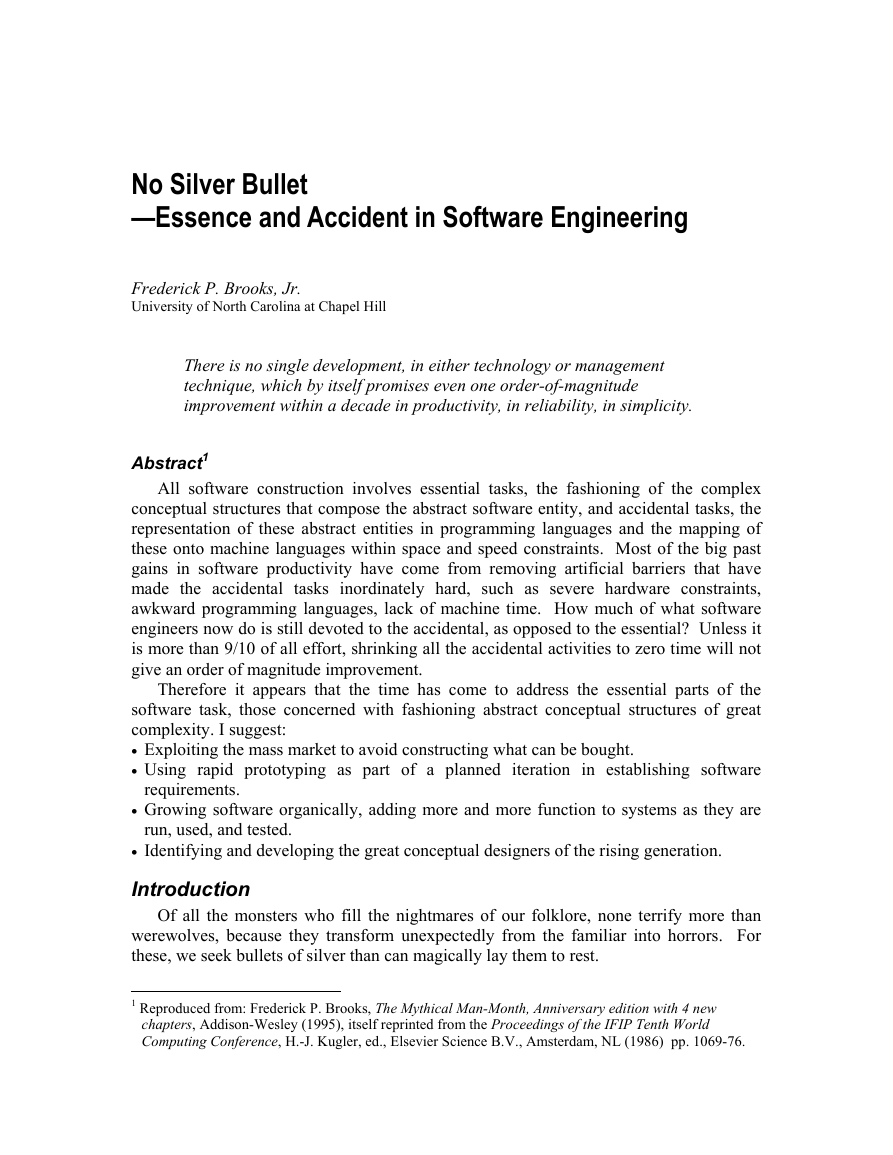
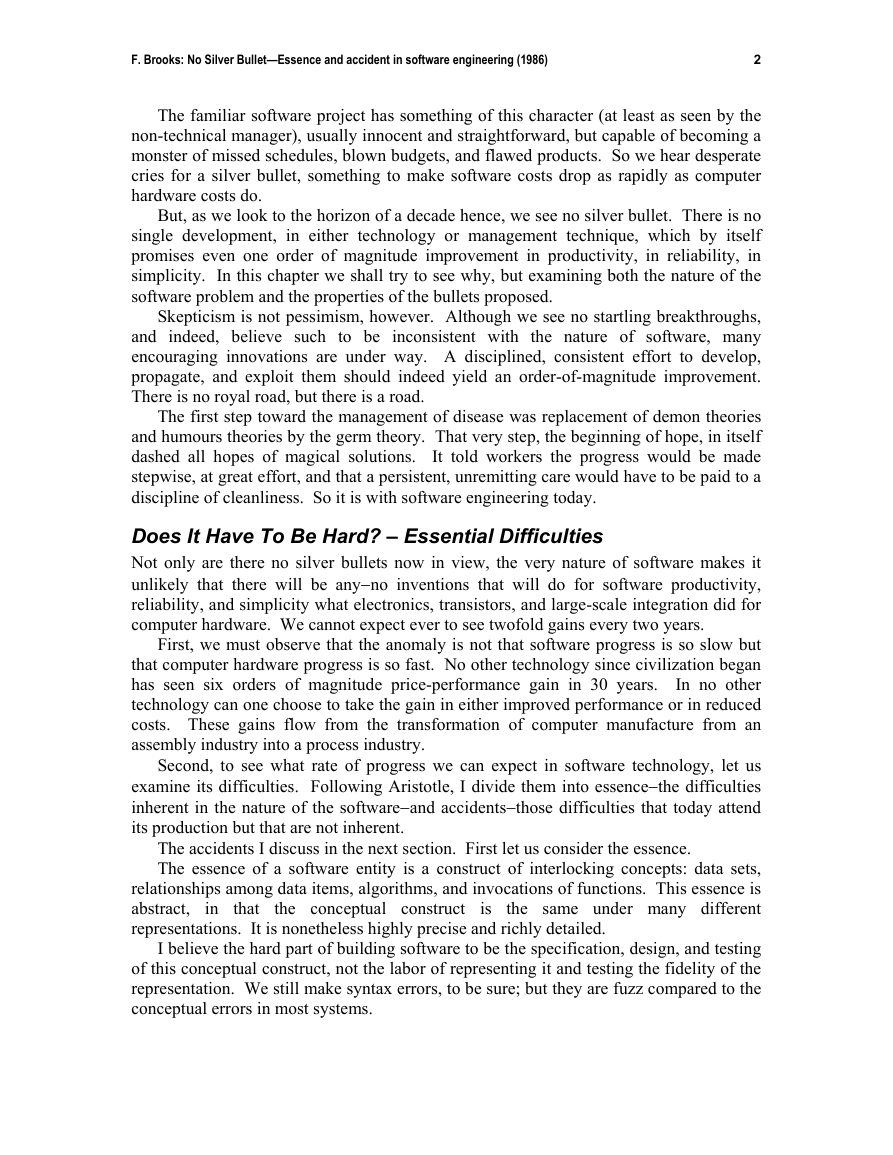
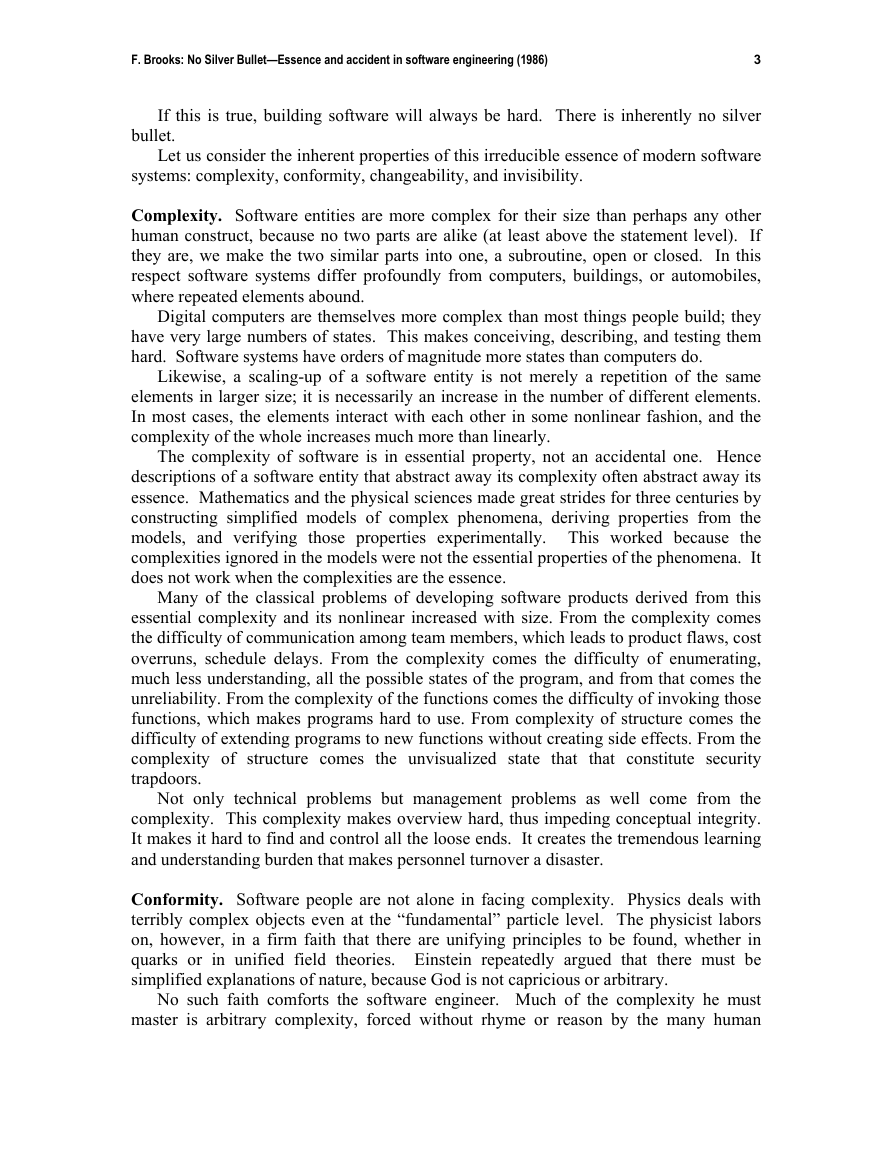
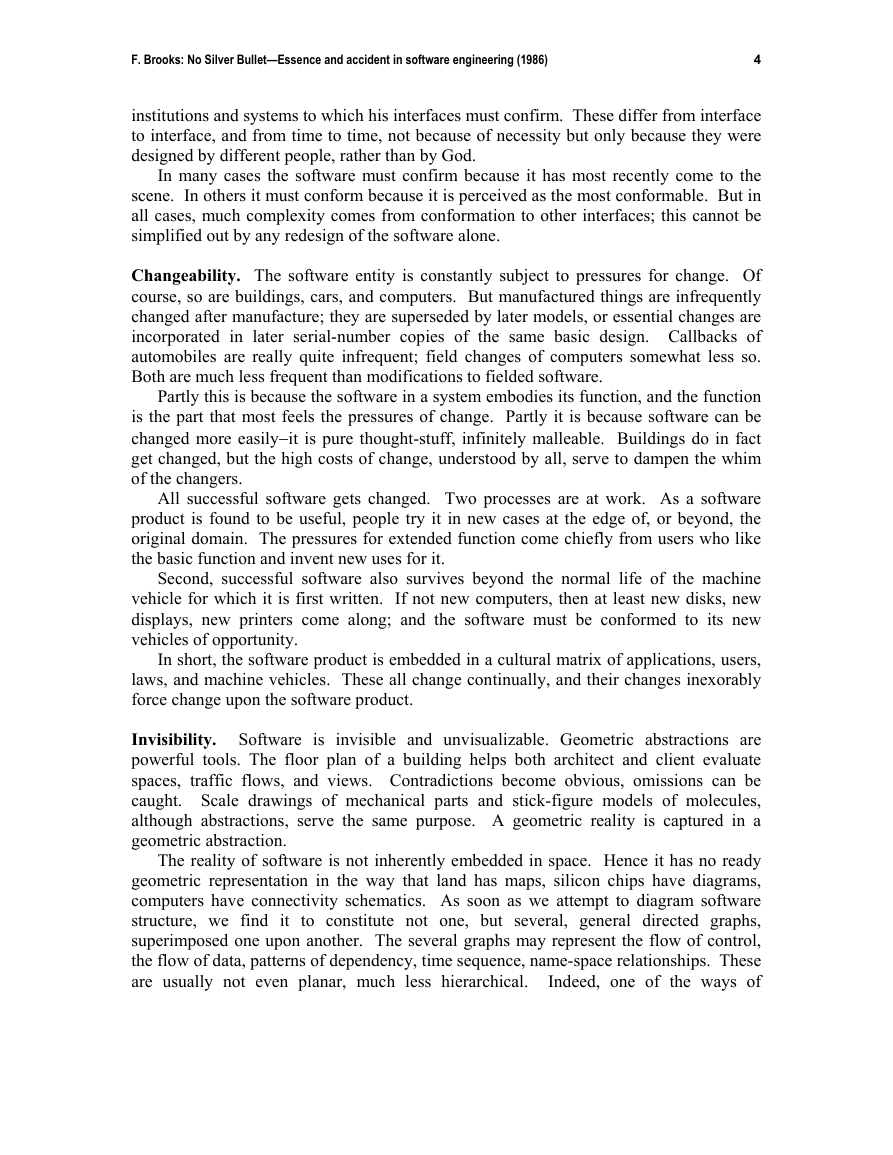
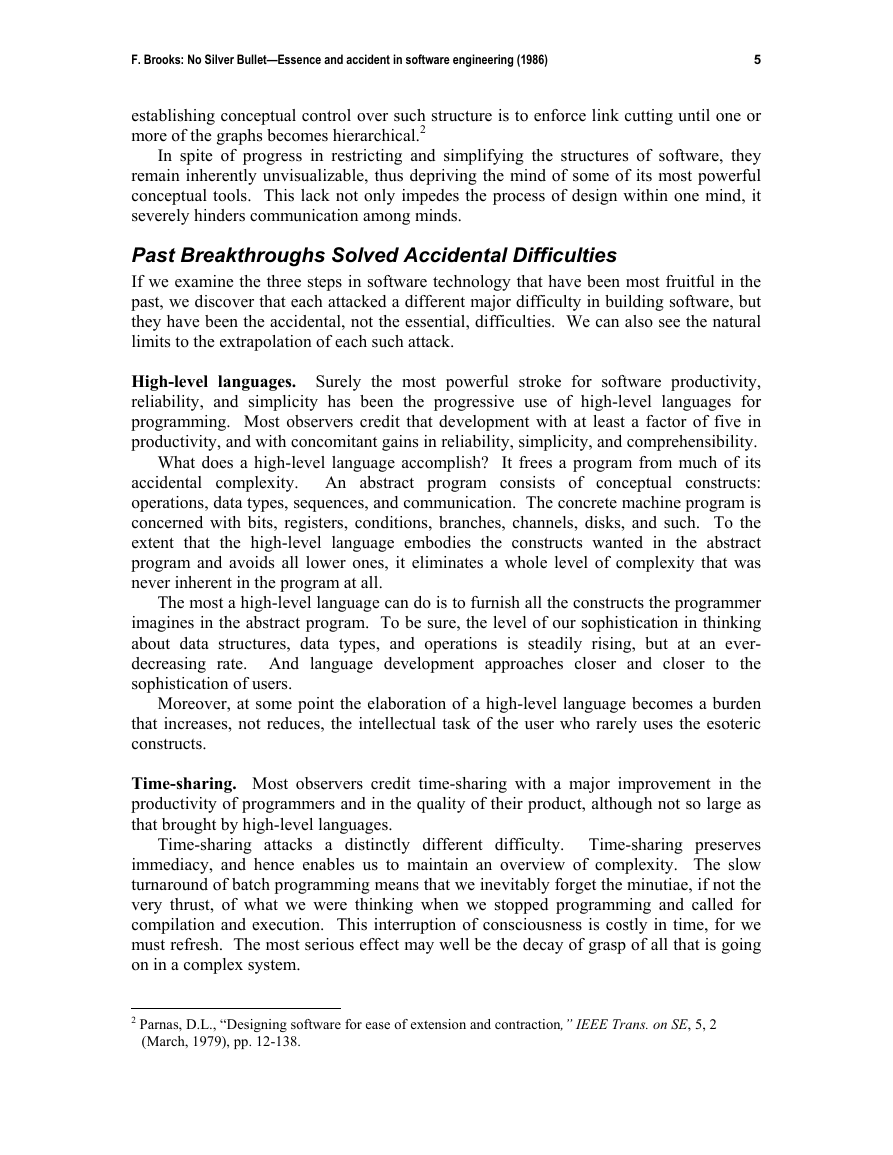

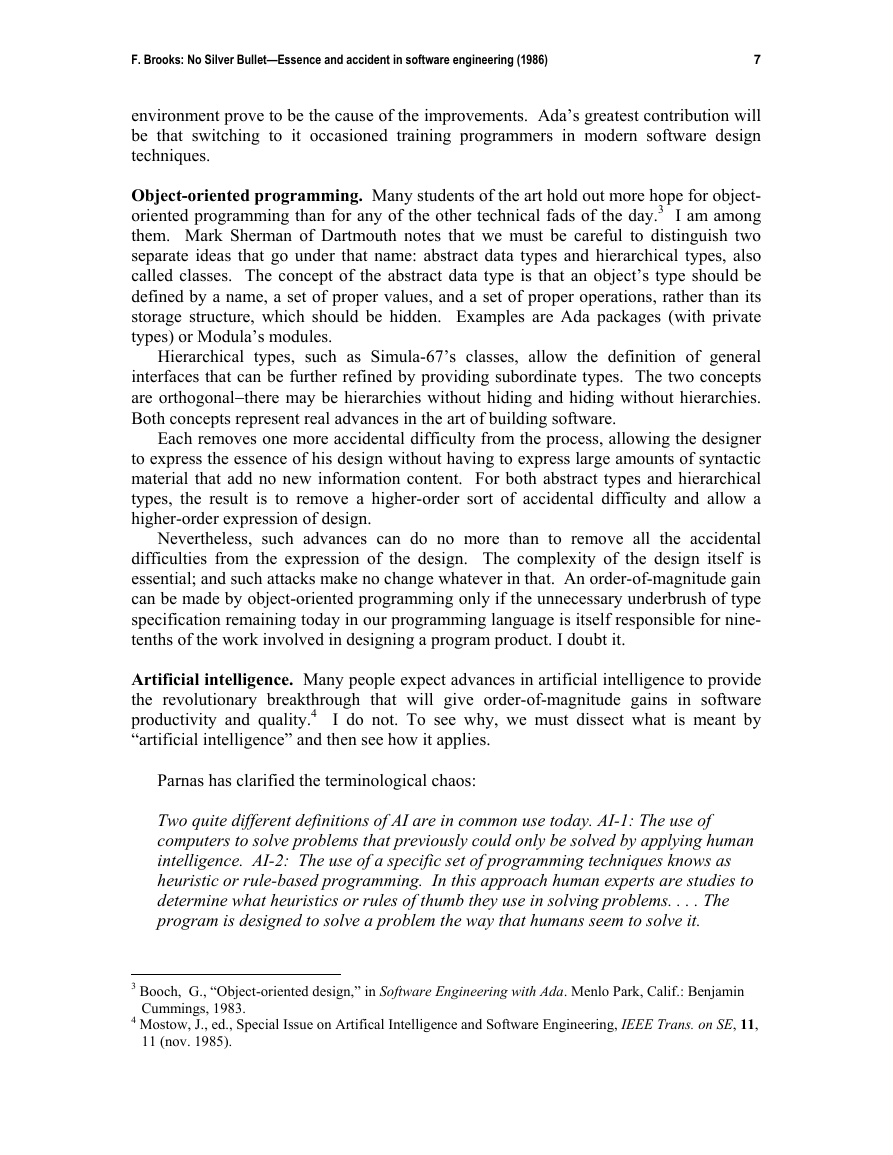
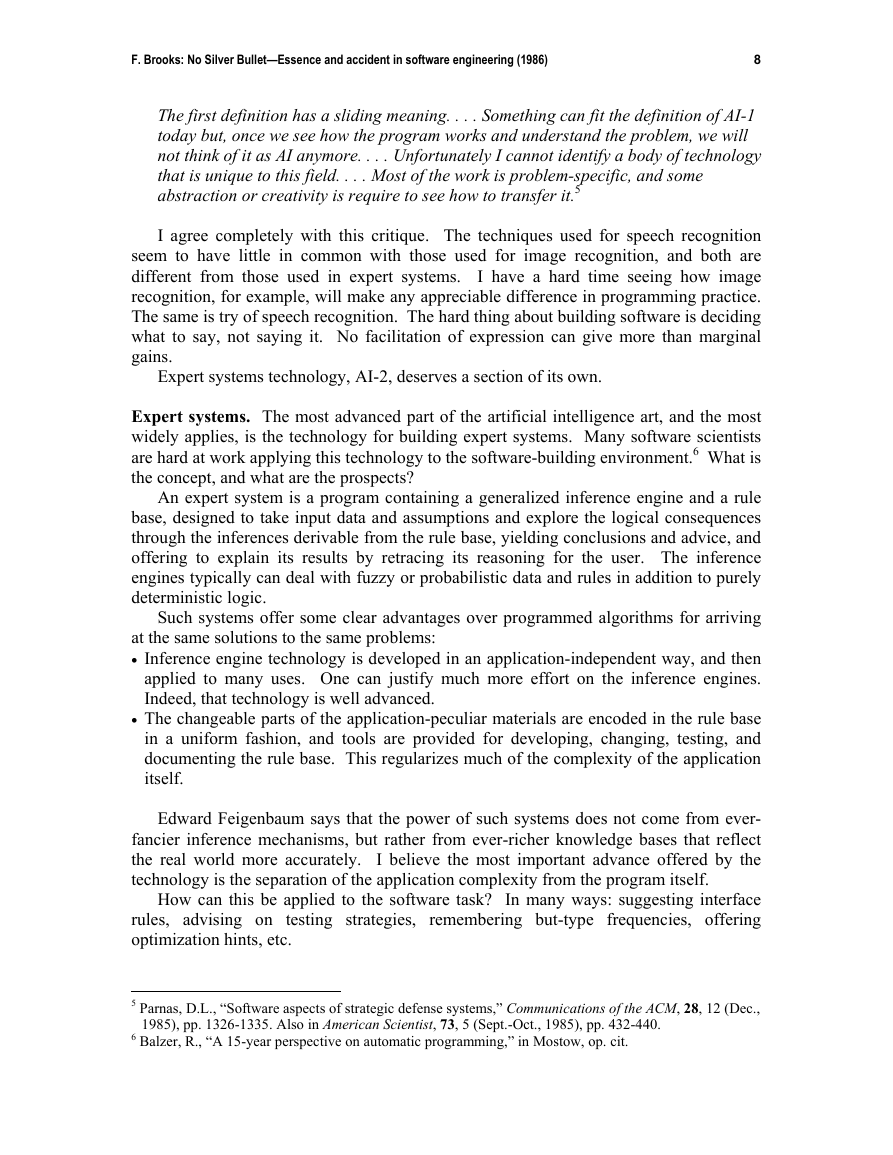








 2023年江西萍乡中考道德与法治真题及答案.doc
2023年江西萍乡中考道德与法治真题及答案.doc 2012年重庆南川中考生物真题及答案.doc
2012年重庆南川中考生物真题及答案.doc 2013年江西师范大学地理学综合及文艺理论基础考研真题.doc
2013年江西师范大学地理学综合及文艺理论基础考研真题.doc 2020年四川甘孜小升初语文真题及答案I卷.doc
2020年四川甘孜小升初语文真题及答案I卷.doc 2020年注册岩土工程师专业基础考试真题及答案.doc
2020年注册岩土工程师专业基础考试真题及答案.doc 2023-2024学年福建省厦门市九年级上学期数学月考试题及答案.doc
2023-2024学年福建省厦门市九年级上学期数学月考试题及答案.doc 2021-2022学年辽宁省沈阳市大东区九年级上学期语文期末试题及答案.doc
2021-2022学年辽宁省沈阳市大东区九年级上学期语文期末试题及答案.doc 2022-2023学年北京东城区初三第一学期物理期末试卷及答案.doc
2022-2023学年北京东城区初三第一学期物理期末试卷及答案.doc 2018上半年江西教师资格初中地理学科知识与教学能力真题及答案.doc
2018上半年江西教师资格初中地理学科知识与教学能力真题及答案.doc 2012年河北国家公务员申论考试真题及答案-省级.doc
2012年河北国家公务员申论考试真题及答案-省级.doc 2020-2021学年江苏省扬州市江都区邵樊片九年级上学期数学第一次质量检测试题及答案.doc
2020-2021学年江苏省扬州市江都区邵樊片九年级上学期数学第一次质量检测试题及答案.doc 2022下半年黑龙江教师资格证中学综合素质真题及答案.doc
2022下半年黑龙江教师资格证中学综合素质真题及答案.doc